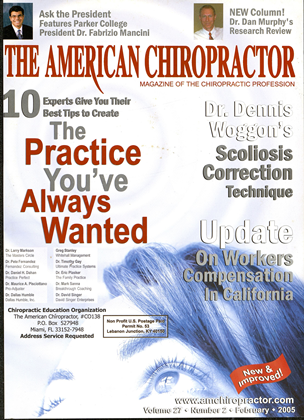£ £ ^Hi HAT WHICH IS OUR GREATEST STRENGTH IS ALSO OUR I greatest weakness." That sounds like a profound I quote from some eccentric philosopher. It's not. I just made it up. But, as far as chiropractic is concerned, I'm convinced it's the truth. Our offices are full of testimonials from patients who swear that we've helped them when no one else had. Some of these testimonials sound like downright miracles! So how is that a weakness? The weakness of chiropractic care I think it has to do with third party reimbursement. When someone other than the patient is considering paying for our services, they DARE to ask us to prove that our patient has a problem and that we can actually help them! It's just not enough anymore for our patients to just tell them how much we're helping them. So, now we're faced with having to prove "medical necessity." We're also asked to document like a medical doctor. As a profession, we've never ) been good at that, nor have we really cared! This is where my story ^ comes in. Several years ago, my bills began to be denied more and more often by insurance companies, because, they said, I did not prove medical necessity. In addition, the personal injury arena seemed to change right before our eyes. We just weren't good at proving that the patient was injured and that what we did had helped. Toward evidence-based So, I embarked on a mission. What I discovered amazed me. The exam that we all learned in chiropractic collegejust wasn't cutting it anymore. As I did more digging, I discovered that we needed to go toward an "evidence-based" model of chiropractic. We needed to do things in our exams that not only fit with our philosophy, but also were accepted in the medical and sci- entific community. Fortunately, I realized that the exam we needed to do was mentioned, in bits and pieces, all over the place. I found components of the exam in the Health Care Financing Administration 's Evaluation and Management Guidelines, as well as in the A MA Guides to the Evaluation of Permanent Impairment. Even one of our own, Dr. Arthur C. Croft, discussed the "evidence-based" examination in his Treatment Guidelines for Cervical Acceleration/Deceleration Injuries. Once I began doing this exam and documenting it the right way, I soon found that my claims were not being denied for lack of medical necessity, my patients were complying more with my treatment recommendations, and they were being sent for IME's less and less frequently. The IME thing bugged me so much that I took training and became certified by the American Board of Independent Medical Examiners. I found out that the IME's that I've seen all these years were bo- gus. They did not follow any semblance of objectivity or even an evidence-based exam, and were full of subjective and biased opinions. Where does this lead? There is software and equipment available today to help us demonstrate the efficacy of chiropractic care. No matter how we may want to treat our patients, our entire standard of care must revolve around the right kind of objective, evidence-based exam. If we are to prove to the world that chiropractic is as effective as we say it is, evidence-based chiropractic is the way we must do it. Our examinations must include scientifically accepted, objective methods that test for changes in function. We must be able to document these objective, functional findings easily and quickly. We must be able to do this with honesty, integrity and dignity. And that is how chiropractic will thrive in the 21s' century. | 17 11111 " I I'l'/ «'V til I t Ml information about i Evidence-based chiropractic examinations must include scientifically accepted, objective methods that test for changes in function and are able to document them.
 View Full Issue
View Full Issue






